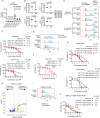Identification of the Notch ligand DLK1 as an immunotherapeutic target and regulator of tumor cell plasticity and chemoresistance in adrenocortical carcinoma
- PMID: 40595495
- PMCID: PMC12216638
- DOI: 10.1038/s41467-025-60649-w
Identification of the Notch ligand DLK1 as an immunotherapeutic target and regulator of tumor cell plasticity and chemoresistance in adrenocortical carcinoma
Abstract
While immunotherapeutic targeting of cell surface proteins is an increasingly effective cancer therapy, identification of new surface proteins, particularly those with biological importance, is critical. Here, we uncover delta-like non-canonical Notch ligand 1 (DLK1) as a cell surface protein with limited normal tissue expression and high expression in multiple refractory adult metastatic cancers including small cell lung cancer (SCLC) and adrenocortical carcinoma (ACC), a rare cancer with few effective therapies. In ACC, ADCT-701, a DLK1 targeting antibody-drug conjugate (ADC), shows in vitro and in vivo activity but is overall limited due to high expression and activity of the drug efflux protein ABCB1 (MDR1, P-glycoprotein). In contrast, ADCT-701 induces complete responses in DLK1+ ACC and SCLC in vivo models with low or no ABCB1 expression. Genetic deletion of DLK1 in ACC dramatically downregulates ABCB1 and increases ADC payload and chemotherapy sensitivity through NOTCH1-mediated transdifferentiation. This work identifies DLK1 as an immunotherapeutic target that regulates tumor cell plasticity and chemoresistance in ACC and supports an active phase I clinical trial targeting DLK1 with an ADC in ACC and neuroendocrine neoplasms (NCT06041516).
© 2025. This is a U.S. Government work and not under copyright protection in the US; foreign copyright protection may apply.
Conflict of interest statement
Competing interests: Nitin Roper and Jaydira Del Rivero have received research funding from ADC Therapeutics for this study. The other authors have no competing interests to report.
Figures






Update of
-
Identification of DLK1, a Notch ligand, as an immunotherapeutic target and regulator of tumor cell plasticity and chemoresistance in adrenocortical carcinoma.bioRxiv [Preprint]. 2024 Oct 11:2024.10.09.617077. doi: 10.1101/2024.10.09.617077. bioRxiv. 2024. Update in: Nat Commun. 2025 Jul 1;16(1):5511. doi: 10.1038/s41467-025-60649-w. PMID: 39416174 Free PMC article. Updated. Preprint.
References
-
- Dumontet, C., Reichert, J. M., Senter, P. D., Lambert, J. M. & Beck, A. Antibody-drug conjugates come of age in oncology. Nat. Rev. Drug Discov.22, 641–661 (2023). - PubMed
-
- Kunnimalaiyaan, M. & Chen, H. Tumor suppressor role of Notch-1 signaling in neuroendocrine tumors. Oncologist12, 535–542 (2007). - PubMed
Publication types
MeSH terms
Substances
Associated data
Grants and funding
LinkOut - more resources
Full Text Sources
Medical

